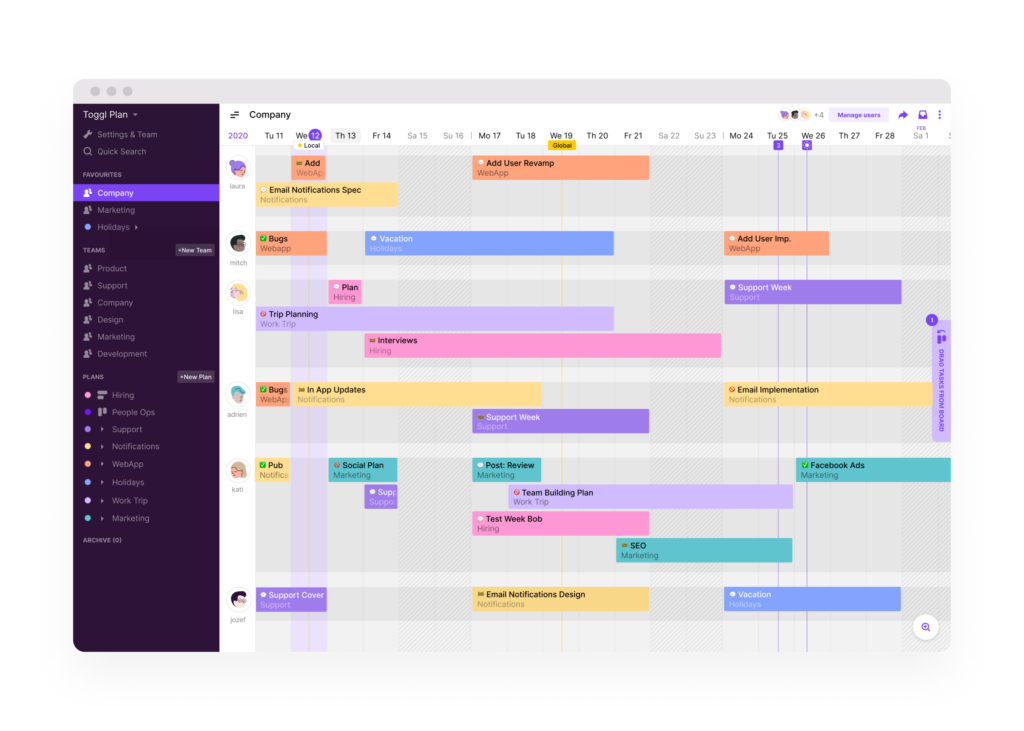What’s the best way to manage a project? Like with most things, the answer is: it depends as each project has requirements. This is where knowledge of project management methodologies comes in hand as it can help project managers figure out the best approach.
To this end, we put together an article about the most popular project management methodologies. But first…What’s a project management methodology?
What’s a project management methodology?
Briefly, a project management methodology is a systematic approach to designing, executing and delivering a project. Project management methodology is a clearly defined combination of related practices, methods, and processes which determine how to best manage workload. It is a model for planning and achieving task goals.
Project management methodologies guide the team through all the phases of a project, with guidance on processes and tasks. These start with help in planning, initiation and implementation, all the way to closure. By providing clear guidance with in-depth descriptions for every step, project management methodologies help teams reduce risks and avoid failure.
Top 5 project management methodologies
While there are over 17 project management methodologies, the ones listed below are the most popular.
Waterfall project management
The waterfall project management methodology is a sequential process. According to it, progress is seen as result flowing from previous steps. This project management methodology was first outlined in the 1950s. Still, the first use of the official “waterfall” name wasn’t until 1976 in a paper written by Bell and Thayer.
The initial waterfall model has 6 main stages:
- Outlining and documenting requirements
- Analysis
- Design & conception
- Development
- Testing/Quality assurance
- Maintenance
As soon as each step is completed, reviewed and verified, project managers can move forward to the next step.
Since waterfall implies a sequence of steps, you cannot go back to a previous step without starting all over from the beginning. This leaves little room for change, so outcomes and a very detailed plan need to be established early on then followed closely.
One of the strong points in waterfall project management methodology is that is stresses rigorous documentation – for example requirements or design document, along with source code. This way, project knowledge can be easily passed on to new team members – in case anyone leaves the project before completion.
Also, because it moves forward in a linear way, projects planned using waterfall are easy to understand and its phases are pretty much self-explanatory. It’s also easy to identify project milestones as moving forward always implies completing a step.
On the downside, in waterfall, you cannot go back to an earlier step to make changes. Also, if the initial requirements are faulty, the result is pretty much doomed, too. Additionally, waterfall leaves little room for changing or evolving needs. If client needs and demands change, projects will take longer and more money to complete. Also, testing or quality assurance take place only further down the line, which makes it harder to detect bugs and predict their overall impact.
Waterfall project management is recommended for projects with fixed scope and requirements or for fixed and stable projects with little change. Also, once the requirements are established, projects that run on waterfall don’t need extensive client presence.
Agile project management
Agile project management came about as a response to rapidly changing demands in software development. Since waterfall doesn’t do a good job accommodating changes, agile stepped in to address these constantly changing needs.
Compared to waterfall, which is linear, agile project management takes an iterative approach to managing tasks and processes. It stems from Toyota’s lean manufacturing approach in the 1940s. Agile focuses on ongoing improvement through continuous releases. Also, it incorporates feedback from previous versions in every new iteration. Speed, team input and delivering high-quality work are all key characteristics of agile project management.
Agile project management grew on software developers quickly as it helps reduce waste and it increases transparency. Also, with continuous releases, agile pushes teams to collaborate and to innovate faster.
Agile project management is based on four core values:
- Individuals and interactions over processes and tools
- Working software over comprehensive documentation
- Customer collaboration over contract negotiation
- Responding to change over following a plan
Besides the 4 core values, Agile also uses a list of 12 principles on matters of collaboration and self-organization. All these are covered in the Agile manifesto.
Agile has won praise because it allows for faster development while reducing waste of resources. Also, it has increased flexibility and is more adaptive to change, making it easier to focus efforts on a specific goal. Agile also allows for quick detection of issues and potential bugs, thus optimizing the development process. It also allows for increased collaboration and feedback and it puts customer needs at the forefront.
Scrum project management
There is a lot of confusion between Scrum and Agile. While Agile refers to a set of methods and principles, Scrum is a framework used to implement Agile methodology
In Scrum, teams work in iterative cycles called sprints. The product owner, the person in charge of creating the product outlines the product vision statement, product roadmap and the project backlog. Along with the development team, the product owner plans what will be delivered at the end of each sprint.
Once a new sprint begins, teams hold short, daily meetings. Here, each tells about what they’re working on and if they have encountered challenges. At the end of each sprint, there is a sprint review that demos the completed work. Next are sprint retrospectives where the team evaluates their way of working and discusses potential problems.
In Scrum, progress needs to be transparent and easily measurable. To this end, teams use six documents to outline requirements and track progress. These are:
- Project vision statement: a document that outlines the main goals of the project
- Project roadmap: a high-level overview or project requirements, along with a timeframe and milestones for delivery.
- Project backlog: this is a list of all the tasks that need to be completed, ordered by priority.
- Release plan: A high-level timeline for releases
- Sprint backlog: A list of goals and task associated with the current sprints.
Implementing Scrum can be easily done with spreadsheets or post-its. That can work well for small teams that share a location. For remote or distributed teams, project managers need proper tools to make ensure transparency. Project planning and roadmap tools such as Toggl Plan allow project managers to run projects in Scrum effectively.
PRINCE2 project management
PRINCE2 stands for PRojects IN Controlled Environments. It is a process-based method for managing projects. Initially used by the UK government, the first framework for PRINCE was developed in the 1980s. After its approach was reviewed and updated in 1996, PRINCE2 became popular across a variety of industries, both in the UK and internationally.
As a project management methodology, PRINCE2 has 5 key features:
- Focus on business justification
- Defined organisation structure for the project management team
- Product-based planning approach
- Emphasis on dividing the project into manageable and controllable stages
- Flexibility that can be applied at a level appropriate to the project.
Since it is a process-based approach, PRINCE2 is governed by principles that control the entire process from start to finish. These make sure that each stage is clearly structured and that there are no loose ends when completing a project. The 6 rules of PRINCE2 are:
- All processes must have a clear business justification. They need to serve a clear need, a realistic customer and defined benefits.
- Project teams should learn at every stage. Every step provides lessons that are recorded and that can be used to improve in the future.
- Clearly defined roles and responsibilities. Every team member should know what they and their mates are responsible for.
- Planning is done in stages. Tasks are splitted into individual phases, with specific milestones and checkups to confirm that everything is on track and according to requirements.
- Project boards manage by exception. Generally, once the requirements are set, project managers have the authority to manage a project without additional input from senior management. However, if issues come up, they can be considered an exception and involve senior management.
- Teams need to constantly keep an eye on quality, checking against requirements
In PRINCE2 there are also 7 stages: starting up, directing, initiating a project, controlling a stage, managing project delivery, managing stage boundaries and closing the project. Additionally, there are 5 roles: the customer, the user (can sometimes be the same as the customer), the supplier, the project manager, the team manager and the administrator.
Compared to previous project management methodologies, PRINCE2 requires experience in order to be implemented. What’s more, there are also available courses that allow project managers to get certification with this methodology.
Kanban project management
Kanban project management was conceived by a Toyota engineer back in 1953. Compared to other project management methodologies, it focuses more on visualizing the workflow in order to balance demand and spot potential bottlenecks.
In Kanban, work is divided into specific stages and steps. Each team member does his/her work then passes the task forward for the next stage to be completed. Kanban is somehow similar to a factory floor where a piece of metal goes through a series of steps to be turned into a finished part.
Kanban requires project managers to define each stage of the workflow. Also, project managers need a system to get a task from one stage to the other. While this sounds easier for physical goods, for knowledge work is can be something like cards – virtual or real. As work on the task progresses, the card is moved to different lists.
Kanban focuses on managing output and efficiency. By doing one thing at a time, it allows project managers to estimate better the workload a specific team member can deliver. Additionally, Kanban is pretty flexible, with only four guiding principles:
- Cards (Kanban translates to “visual card”): Each task has a card with all the relevant information needed to complete the tas
- Cap on work in progress: To avoid burnout, project managers need to limit how many cards are in play at once
- Continuous Flow: Prioritize according to importance and make sure there always is a workload
- Constant improvement: Analyze the flow to determine efficiency and what can be improved
Compared to other project management methodologies, Kanban is a bit more laid back. With no sprints, assigned roles or specific milestones, team members can focus freely on the task at hand. Also, meetings are defined according to team needs, instead of regular process meetings.
Like Scrum, Kanban is great for teams that don’t need a lot of management and are self-motivated. It can also help project managers focus on efficiency, thus saving resources. If project managers are careful not to overload, projects can be completed in time and within budget. However, Kanban works best where skills are evenly distributed, sometimes overlapping in a team. If one team member has a specific in-demand skill, that can hold up the project.




